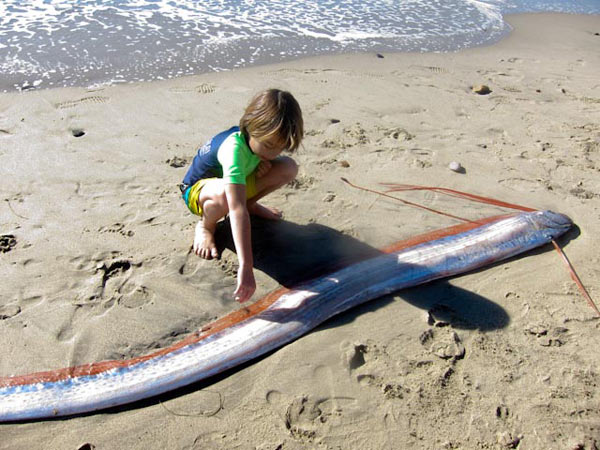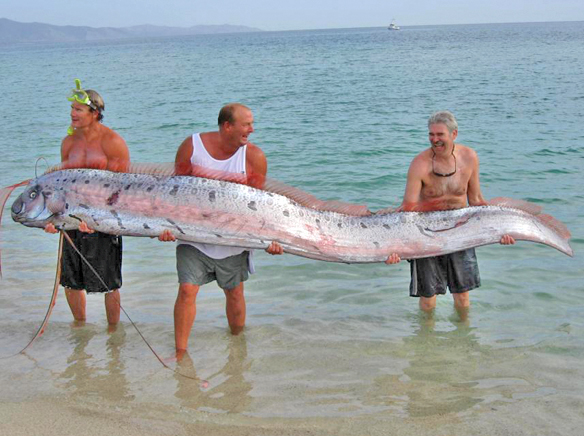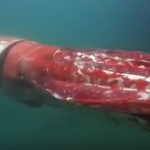A recent string of oarfish have washed ashore in California. And by recent string I mean two. On October 18th, a pregnant 14-foot long female was found dead on an Oceanside, California beach. On October 13th, an 18-foot dead oarfish was found a by a snorkeler and drug ashore off Catalina Island.
 This, ahem, pattern is causing people to ask, “Why are so many oarfish washing ashore?” In the words of @para_sight on Twitter, “Two is not a trend.” To put in a nerdier statistical way, like you would expect anything less from DSN, you can fit a regression line to two points and get a great fit, but it’s questionable since the degrees of freedom is ONE. To give you an example, my dog has taken a dump in a field of wildflowers twice this year. Should the public infer my dog only leaves fecal deposits near wildflowers?
This, ahem, pattern is causing people to ask, “Why are so many oarfish washing ashore?” In the words of @para_sight on Twitter, “Two is not a trend.” To put in a nerdier statistical way, like you would expect anything less from DSN, you can fit a regression line to two points and get a great fit, but it’s questionable since the degrees of freedom is ONE. To give you an example, my dog has taken a dump in a field of wildflowers twice this year. Should the public infer my dog only leaves fecal deposits near wildflowers?
Let’s take a step back. Regalecus glesne is the longest of the bony fishes. The longest confirmed specimen was 36.09 feet (11 meters) in length. A more common length is around 9.84 feet (3 meters). The Giant Oarfish is also typically a deep-sea fish found between 200-1000 meters and found in all of the major oceans. Giant Oarfish feed on krill, small fish, and squid. They spawn late in year and oarfish larvae can be easily found at the surface. The Giant Oarfish was described in 1772 and the scientific name refers to “belonging to a king” and the farm at Glesvær (not far from Norway’s second largest city of Bergen) where the type specimen was found.
 Undoubtedly the length, odd appearance, and their deep habitat make them of great interest to the public and scientists alike. However, oarfish washing ashore is not exactly a rare event. On September 24, 2013 a “mysterious creature”, more than likely an oarfish, washed ashore in Spain. May 13, 2010 in Sweden. February 25, 2009 in England. January of 2012 in Florida. I’m going to stop here but let’s just say I could keep going for a while. There are literally hundreds of such cases.
Undoubtedly the length, odd appearance, and their deep habitat make them of great interest to the public and scientists alike. However, oarfish washing ashore is not exactly a rare event. On September 24, 2013 a “mysterious creature”, more than likely an oarfish, washed ashore in Spain. May 13, 2010 in Sweden. February 25, 2009 in England. January of 2012 in Florida. I’m going to stop here but let’s just say I could keep going for a while. There are literally hundreds of such cases.
So while two oarfish washing ashore (say that 10 times really fast) in California within a week of one another is interesting it doesn’t demand we search for a reason. But, the media is searching for an answer for this pattern. And in drudging around someone hit on what has to be the worst idea. In Japanese folklore, the oarfish is known as the Messenger from the Sea God’s Palace and appears on beaches to predict earthquakes. Of course anytime something washes ashore in California, someone want to tie it to earthquakes.
First, I cannot seem to find any references to the original sources of this myth. Hopefully someone in the comments below can provide a link to something other than the mass media hysteria.
Second, the evidence given for this phenomenon is the unusual numbers of oarfish that washed ashore in December 2009 to March 2010 off Japan. According to LiveScience, “Shortly before the 2011 Tohoku earthquake and tsunami [March 11, 2011] struck Japan, about 20 oarfish stranded themselves on beaches in the area.” The evidence of the oarfish washing ashore can be found in a piece in the Telegraph before the tsunami. But only a few were actually washed ashore. Most were caught in nets…not even close to the same thing.
Third, Pat Abott, a seismologist at San Diego State, also makes another great point,
“The science and study just isn’t there. There’s a big difference between suggesting something like that and proving it. What did an animal sense that maybe we didn’t that told them about a coming event?” In other words, there is no systematic study that exists that finds a link between oarfish strandings and earthquakes. None, zip, zilch, zero, nadda.
Fourth, what about all the sizable earthquakes and tsunamis that have occurred without any warning from our oarfish friends? 1/10 is really shit odds. Of course that is just major earthquakes. I guess they can’t be trusted for anything less than 8.0 magnitude. You suck oarfish.
Fifth, earthquakes happen all the time in California. Where in the hell were the oarfish in May during the 5.7 quake at Canyondam or the 4.8 quake at Isla Vista? I mean sure they are minor quakes and I don’t expect an oarfish to kill itself on a beach for me every time but surely an oarfish has the time to tweet at me? So basically oarfish are doing a crappy job of predicting California earthquakes.
Sixth, as put by HJ Walker, from the Scripps Institution of Oceanography in California, “If there is a enormous giant earthquake beneath the sea, other fish would be affected – not just one or two oarfish.”
Seventh, there are better more plausible explanations. Disease, sudden environmental changes, currents, anything is more plausible than an earthquake. Kim, a highly trained physical oceanographer, makes a great case for abnormal currents. Giant squid strandings increased when there are rises in bottom temperature. Or as my friend, a trained ecologist (h/t to S.V.T), mentioned animals are distributed patchily across the planet. Basically, you don’t find a species everywhere and where you do find there is usually more than one. Where one oarfish is there are bound to be others nearby.
Share the post "Oarfish Can Supposedly Predict Earthquakes, Apparently They Suck At It"








The 11 meter length for Oarfish comes from A Field Guide to Pacific Coast Fishes: North America, which offers no explanation for where that figure came from. According to Benfield et al. 2013, the “actual recorded LT of confirmed oarfish specimens are no larger than 7–8 m”.
wait… my dog took a dump in a field of wildflowers twice this year as well…. OMG!!! IT’S AN EPIDEMIC!!
Breaking news: A 7.6 magnitude earthquake struck 231 miles east of the Japanese island of Honshu, the U.S. Geological Survey reported. A U.S. Pacific tsunami warning center said there was no destructive widespread tsunami threat following the quake.
Just now: “A magnitude 7.3 earthquake struck off the Fukushima region of Japan, according to the U.S. Geological Service.”
cough cough ;o)….http://www.foxnews.com/world/2013/10/25/73-magnitude-earthquake-hits-japan/
Funny… http://www.foxnews.com/world/2013/10/25/73-magnitude-earthquake-hits-japan/
7.6 now. Apparently your article’s headline sucks.
M 7.3 Earthquake
Off the east coast of Honshu, Japan
7 hours ago – U.S. Geological Survey
An earthquake with magnitude 7.3 occurred near Iwaki, Honshu, Japan at 17:10:16.70 UTC on Oct 25, 2013 …
Yes Yes I know everyone that a earthquake happened of Japan. Still if oarfish washing ashore in California are predicting any scale earthquake in any part of the world…well then oarfish still suck at predicting earthquakes.
Well, they may suck at it – but you have to admit it is kinda funny that there was a quake only a couple days later. LOL!
As Cameron already noted, oarfish suffer notoriously from big-fish-stories and get nowhere as big as usually said. It´s a quite common phenomen that unconfirmed reports of alleged giant specimens found their way even into scientific literature and were copied and repeated again and again for decades or even more than a century. For some reasons even ichthyologists who should know better show often quite little sceptisism, even if there is nowhere any photographic or physical evidence for specimens as big as the claimed giants. For this reason you can still find a lot of claims of 4,5 m arapaimas, 5 m wels catfish, 8 m sturgeons or in this case 11 m oarfish. There are of course many more cases, especially among fish and reptiles. In some cases it´s even possible to track down the original sources from which the phantastic sizes come from, and like in the case of the arapaima it came out it was nothing but hearsay with massive contradictions.
Over the time of more than a century a lot of oarfish were recorded around the world, and as they are so extremely unusual in appearance, the discoveries were probably made public in a lot of cases, and photos taken as well. But yet, among all the oarfish which were photographed or even completely or partly preserved for collections, none was only close to the often cited maximum length of 11 m. The very largest ones were around 6 m, what is already much more than average, and then there is this huge specimen of around 7 m found at the Naval Amphibious Base Coronado in 1996. Some years ago there was a specimen found in Mexico which was said to be 8 m in length, but a quite simple measurement at the photo revealed it was in fact only around 6 m. The famous specimen in the Natural History Museum at Vienna is 6 m in length, and was at this time at the upper end of confirmed sizes, and actually, it still is.
So if oarfish would really reach 11 m, we would know much more specimens of 7, 8, 9 or 10 m. You have to keep in mind that weight increases with the cube, and an 11 m oarfish would be around 7 times as massive as a 6 m specimen, which is already an exception. What´s even weirder is the fact that the claimed sizes for Regalecus glesne don´t stop at 11 m. Many authors give even maximum lengths of 14 m, 17 m or even more than 20 m. I think none of them has really an idea how big such a fish would really be. And the real problem is that people want to believe in such claims, because it´s a cool imagination such huge beasts are out there in the seas. It was not that long ago that you could find 11 m as maximum length for the great white shark in many books, and the erroneous 18 m or 21 m for the giant squid are still quite common even in the latest literature.
Even if we keep in mind that the very largest oarfish are bigger than the largest ones which were actually confirmed, it´s quite unprobable they are much bigger than the very largest on record, what would indicate a maximum length of around 7 to possibly 8 m at the very extreme.
I wonder; does the navy’s underwater activities have anything to do with the beaching of marine life?
Wow
That is a big fish